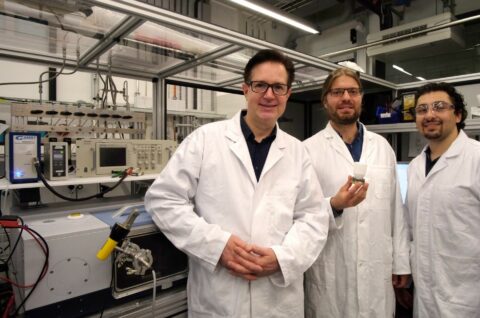Electrifying Chemistry under the Looking Glass

The future perspective of chemistry is ‘electrifying’: With increasing availability of cheap electrical energy from renewables it will soon become possible to drive many chemical processes by electrical power. In this way, chemical products and fuels can be produced via sustainable routes, replacing current processes which are based on fossil fuels.
In most cases, such electrically driven reactions make use of so called electrocatalysts, complex materials which are assembled from a large number of chemical components. The electrocatalyst plays an essential role: It helps to run the chemical reaction while keeping the loss of energy minimal, thereby saving as much renewable energy as possible. In this way, important energy carriers such as hydrogen can be produced by splitting of water or climate gases such as carbon dioxide can be converted to valuable chemicals. In most cases, electrocatalysts are developed empirically and the chemical reactions at their interfaces are poorly understood. A better understanding of these processes is essential, however, for a faster develop of new electrocatalysts and for a directed improvement of their lifetime, one of the most important factors that currently limit their applicability.
As reported in the journal Nature Materials, researchers from the Friedrich-Alexander-Universität Erlangen-Nürnberg (FAU), the Helmholtz-Institute for Renewable Energies Erlangen-Nürnberg (HI-ERN) and international partner groups have now developed a new method to better understand electrocatalysis at the atomic level. In cooperation with the group of Prof. Karl Mayrhofer (HI-ERN), the group of Prof. Jörg Libuda (FAU) demonstrated that it is possible to assemble a complex electrocatalyst with atomic level control and to use such a system to study the individual steps of an electrically driven reaction. The catalysts are assembled under so called ultrahigh vacuum conditions, i.e., in the complete absence of contaminants that normally influence the the scientific measurements. Following this new strategy, it will now be possible to build a wide range of new electrocatalysts with unprecedented control over their structure and composition, thus helping to develop a much better fundamental understanding of the ‘electrifying’ chemistry of the future.
For further informationen:
Nature Materials (2018): https://doi.org/10.1038/s41563-018-0088-3
Prof. Dr. Jörg Libuda
91058 Erlangen
- Phone number: +49 9131 85-67661
- Email: joerg.libuda@fau.de
- Website: https://www.ecrc.fau.eu/libuda-group/
